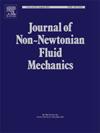The critical plastocapillary number for a Newtonian liquid filament embedded into a viscoplastic fluid
IF 2.8
2区 工程技术
Q2 MECHANICS
引用次数: 0
Abstract
The yield stress of a viscoplastic material can stabilize an embedded fluid tunnel against capillarity-induced breakup, enabling remarkable technologies such as embedded 3D printing of intricate, freeform, and small components. However, there is persistent disagreement in the published literature between the observed minimum stable diameter, , and the theoretical plastocapillary length , with interfacial tension and bath yield stress , leading to a prior hypothesis that the apparent surface tension is much smaller to enforce . Here we introduce and experimentally test a new hypothesis that the critical diameter is set by the dimensionless plastocapaillary number, , having a non-trivial critical value different than one, , and therefore the prior hypothesis of adjusting to enforce is incorrect. We study several Newtonian inks (uncured polydimethylsiloxane (PDMS), highly refined mineral oil, silicone oil) extruded into a wide range of non-Newtonian viscoplastic bath materials (polyacrylic acid microgels, polysaccharide microgels, nanoclay gel, and micro-organogels). Across this wide parameter space, we observe a critical value of . We explain this being less than one by analogy to other critical dimensionless groups with yield stress fluids, such as the gravitational stability of a suspended sphere or bubble, where the yield stress acts upon an effective area larger than the naïve estimate set only by embedded object diameter . These results provide a new way to understand and predict the minimum stable diameter of embedded liquid filaments, as in embedded 3D printing, as .
在粘塑性流体中嵌入牛顿液体细丝的临界塑性毛细管数
粘塑性材料的屈服应力可以稳定嵌入的流体隧道,防止毛细血管引起的破裂,从而实现复杂、自由形状和小型部件的嵌入式3D打印等卓越技术。然而,在已发表的文献中,观察到的最小稳定直径dmin和理论塑性毛细管长度Lpc=2Γ/σy,界面张力Γ和熔池屈服应力σy之间一直存在分歧,导致先前的假设,即表观表面张力Γ要小得多,以执行dmin=Lpc。在这里,我们引入并实验验证了一个新的假设,即临界直径由无因次的塑胞数YΓ=σyd/2Γ设定,具有不同于1的非平凡临界值YΓc≠1,因此调整Γ以强制执行Lpc=dmin的先前假设是不正确的。我们研究了几种牛顿油墨(未固化的聚二甲基硅氧烷(PDMS),高度精炼的矿物油,硅油)挤压成各种非牛顿粘塑性浴材料(聚丙烯酸微凝胶,多糖微凝胶,纳米粘土凝胶和微有机凝胶)。在这个宽的参数空间中,我们观察到一个临界值YΓc=0.21±0.03。我们通过类比其他具有屈服应力流体的临界无量纲群来解释这个小于1,例如悬浮球体或气泡的重力稳定性,其中屈服应力作用于有效面积大于仅由嵌入物体直径d设置的naïve估计。这些结果为理解和预测嵌入液体细丝的最小稳定直径提供了一种新的方法,如在嵌入式3D打印中,dmin=YΓc(2Γ/σy)。
本文章由计算机程序翻译,如有差异,请以英文原文为准。
求助全文
约1分钟内获得全文
求助全文
来源期刊
CiteScore
5.00
自引率
19.40%
发文量
109
审稿时长
61 days
期刊介绍:
The Journal of Non-Newtonian Fluid Mechanics publishes research on flowing soft matter systems. Submissions in all areas of flowing complex fluids are welcomed, including polymer melts and solutions, suspensions, colloids, surfactant solutions, biological fluids, gels, liquid crystals and granular materials. Flow problems relevant to microfluidics, lab-on-a-chip, nanofluidics, biological flows, geophysical flows, industrial processes and other applications are of interest.
Subjects considered suitable for the journal include the following (not necessarily in order of importance):
Theoretical, computational and experimental studies of naturally or technologically relevant flow problems where the non-Newtonian nature of the fluid is important in determining the character of the flow. We seek in particular studies that lend mechanistic insight into flow behavior in complex fluids or highlight flow phenomena unique to complex fluids. Examples include
Instabilities, unsteady and turbulent or chaotic flow characteristics in non-Newtonian fluids,
Multiphase flows involving complex fluids,
Problems involving transport phenomena such as heat and mass transfer and mixing, to the extent that the non-Newtonian flow behavior is central to the transport phenomena,
Novel flow situations that suggest the need for further theoretical study,
Practical situations of flow that are in need of systematic theoretical and experimental research. Such issues and developments commonly arise, for example, in the polymer processing, petroleum, pharmaceutical, biomedical and consumer product industries.

 求助内容:
求助内容: 应助结果提醒方式:
应助结果提醒方式:


